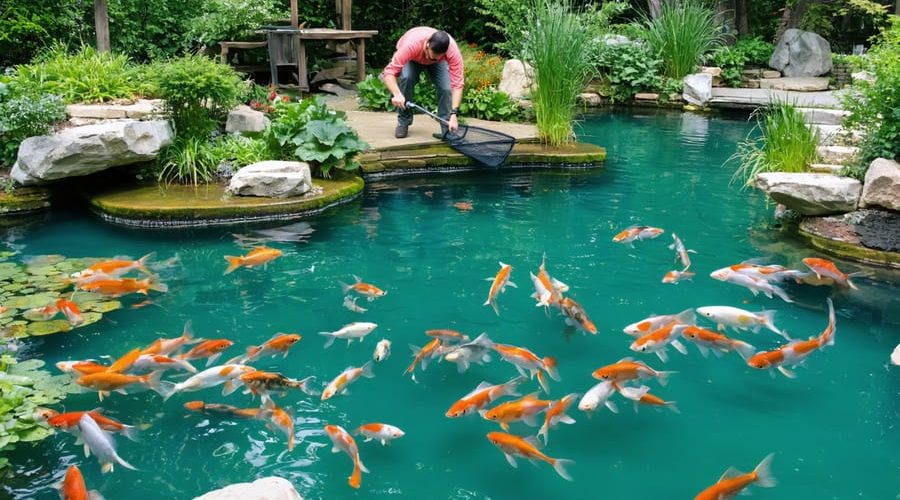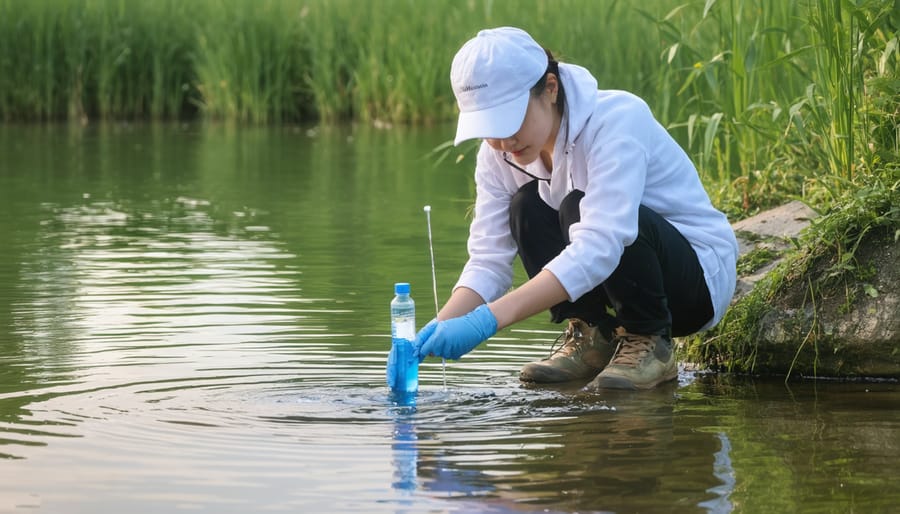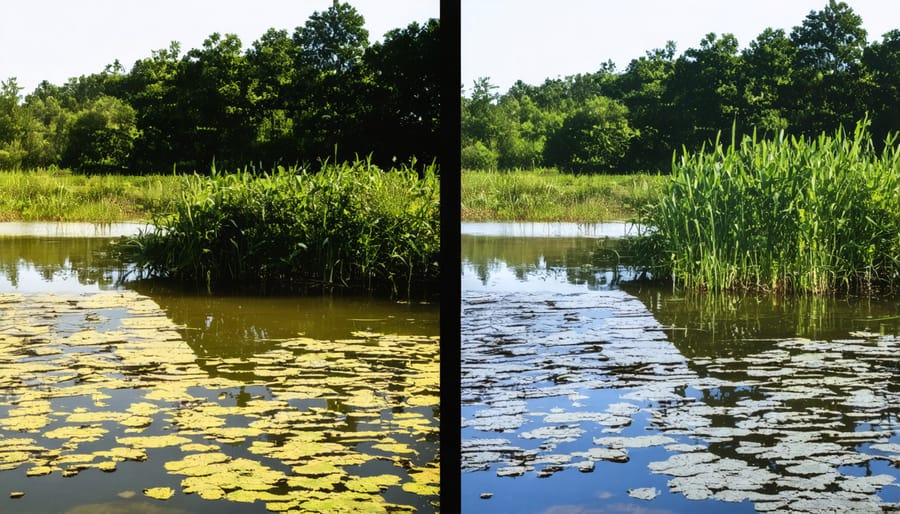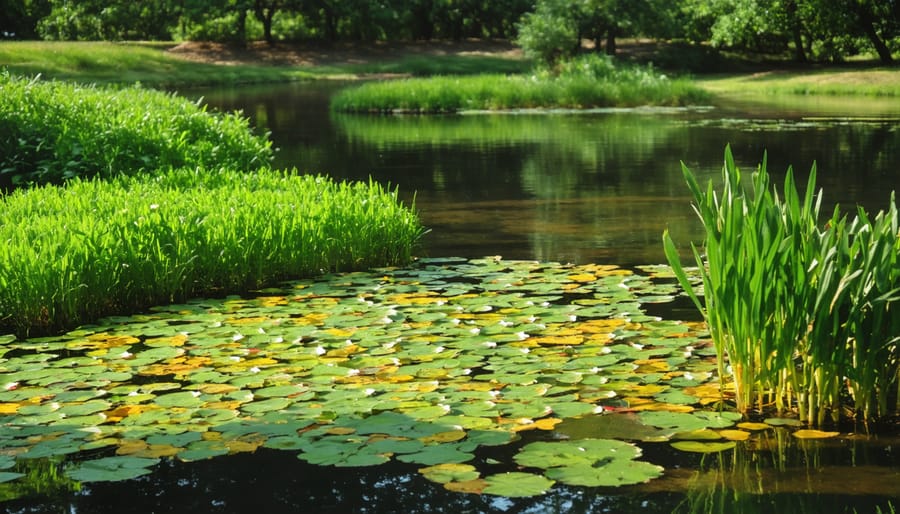
Keep Your Backyard Pond Crystal Clear All Year (Without Breaking the Bank)
Monitor water quality weekly using test strips to check pH, ammonia, and nitrate levels – these essential pond maintenance tips prevent algae blooms and keep fish healthy. Remove fallen leaves and debris with a pond net before they sink and decompose, which helps maintain oxygen levels and water clarity. Install an appropriately-sized pump and filter system based on your pond’s volume, running it 24/7 to keep water moving and properly filtered. Maintain aquatic plants by trimming dead foliage, dividing overcrowded species, and ensuring they cover about 60% of the water’s surface to naturally balance the ecosystem. Regular maintenance not only preserves your pond’s beauty but also creates a thriving habitat that requires less intervention over time.
Essential Water Quality Management
Testing and Monitoring
Regular water testing is your pond’s health check-up, and it’s easier than you might think! Aim to test your pond water every two weeks during peak season (spring and summer) and monthly during cooler periods. Essential parameters to monitor include pH levels (ideally between 6.8-7.8), ammonia (should be 0 ppm), nitrites (0 ppm), and dissolved oxygen levels.
You can find user-friendly testing kits at most garden centers. These typically come with color-matching charts that make reading results a breeze. Pay special attention to water clarity – you should be able to see at least 12-18 inches deep in your pond. Cloudy or green water often signals an imbalance that needs addressing.
Keep a simple log book to track your readings. This helps you spot trends and catch potential problems early. For example, if you notice pH levels slowly climbing over several readings, you can take corrective action before it affects your fish or plants.
Watch for these warning signs that suggest immediate testing is needed:
– Fish gasping at the surface
– Sudden algae growth
– Unusual water color
– Strong odors
– Plant deterioration
Remember, prevention is better than cure! Regular monitoring helps maintain a healthy ecosystem and saves you time and money in the long run. If you’re unsure about your readings, most local garden centers offer free water testing services.

Balancing pH and Chemical Levels
Maintaining proper water chemistry in your pond is crucial for the health of your fish and plants. The key is to regularly test and adjust your pond’s pH level, which should ideally stay between 6.8 and 7.8. Purchase a reliable water testing kit from your local garden center and test your pond water weekly during peak season.
If your pH is too high, you can lower it naturally by adding peat moss in mesh bags or using commercial pH-down products. For low pH levels, gradually add small amounts of baking soda or limestone to raise it. Remember to make adjustments slowly to avoid shocking your pond’s ecosystem.
Beyond pH, keep an eye on ammonia, nitrite, and nitrate levels. These chemicals come from fish waste and decomposing plant matter. A healthy biological filtration system helps manage these levels naturally. Add beneficial bacteria products monthly to help break down waste and maintain clear water.
Dissolved oxygen is another vital component of pond chemistry. Running fountains or waterfalls not only looks beautiful but also helps oxygenate the water. In summer months, when oxygen levels naturally decrease, consider adding an air pump or additional water movement features.
Want to make testing easier? Create a simple maintenance schedule and keep a log of your readings. This helps you spot trends and address problems before they become serious issues. Remember that a stable pond environment is always better than perfect readings that fluctuate wildly.
Filtration System Care
Mechanical Filter Maintenance
Regular maintenance of your pond’s mechanical filter is crucial for keeping your water crystal clear and your aquatic friends happy. Even the best filtration systems need proper care to function effectively.
Start by checking your filter at least once a month during peak season (spring and summer) and every two months during cooler periods. Here’s a simple maintenance routine you can follow:
1. Turn off the pump before cleaning to prevent debris from flowing back into the pond.
2. Remove the filter unit carefully, keeping it close to the pond to avoid disturbing beneficial bacteria.
3. Open the filter housing and remove any large debris by hand. You’ll be surprised how much can accumulate!
4. Gently rinse filter media with pond water, not tap water. This preserves beneficial bacteria that help break down waste.
5. Check for tears or damage in filter materials and replace if necessary.
6. Clean the filter housing thoroughly, paying special attention to inlet and outlet points.
7. Reassemble the filter, ensuring all seals are properly aligned to prevent leaks.
8. Restart the pump and check for proper water flow.
If you notice decreased water flow between cleanings, your filter might need attention sooner. During fall, when leaves are falling, you might need to clean more frequently. Keep a maintenance log to track cleaning dates and any issues you notice – this helps establish the perfect maintenance schedule for your specific pond.
Remember, a well-maintained filter not only keeps your pond looking beautiful but also creates a healthier environment for your fish and plants.

Biological Filter Care
A healthy biological filter is the heart of your pond’s ecosystem, working tirelessly to break down harmful waste and keep your water crystal clear. To maintain this essential system, start by never cleaning all your filter media at once. Instead, clean different sections on a rotating schedule to preserve the beneficial bacteria colonies that do all the heavy lifting.
When cleaning your filter media, use pond water rather than tap water. Tap water contains chlorine and other chemicals that can kill beneficial bacteria. Gently rinse the media to remove debris while leaving the good bacteria intact. Think of it like dusting your furniture rather than scrubbing it clean.
During warmer months, check your biological filter weekly for any clogging or reduced flow. A properly functioning filter should have steady water flow and shouldn’t emit any unpleasant odors. If you notice the flow decreasing, it’s time for a gentle cleaning.
In winter, your biological filter needs special attention. As temperatures drop, bacterial activity slows down but doesn’t stop completely. If you live in a mild climate, keep your filter running year-round. In colder regions, you may need to remove and store the filter media in a frost-free location.
Add beneficial bacteria supplements monthly during the growing season to maintain a robust colony. After heavy rains or major cleanings, consider adding an extra dose to replenish any bacteria that may have been washed away.
Remember that establishing a healthy biological filter takes time – typically 4-6 weeks for new ponds. Be patient and avoid the temptation to over-clean, as this can disrupt the natural balance your filter works so hard to maintain.

Vegetation Management
Plant Care and Trimming
Proper plant care is essential for maintaining a healthy and vibrant pond ecosystem. In spring, start by removing any dead or decaying plant material that accumulated over winter. Trim back emerging water lilies and marginal plants to encourage healthy new growth. As plants begin to grow, add aquatic fertilizer tablets near their roots to provide essential nutrients.
During summer, regular maintenance becomes crucial. Remove yellowing or dead leaves from floating plants and trim back aggressive spreaders to prevent them from taking over. Water lilies benefit from deadheading spent blooms, which encourages continuous flowering throughout the season. Keep an eye on oxygenating plants – while they’re vital for pond health, they can grow rapidly and may need thinning every few weeks.
Fall maintenance focuses on preparing plants for winter. Cut back marginal plants to about 2-3 inches above the water line. Remove tropical water lilies and store them indoors if you live in a cold climate. Hardy water lilies can remain in the pond but should be trimmed back to prevent decay during winter months.
Year-round, maintain a balance of different plant types: floating, marginal, and submerged. This creates a natural ecosystem and helps keep algae growth in check. When adding new plants, introduce them gradually to avoid overwhelming your pond’s ecosystem. Remember to keep approximately 60% of your pond’s surface free from floating plants to ensure adequate light penetration and oxygen exchange.
Algae Prevention
Keeping algae under control is crucial for maintaining a healthy and attractive pond. While some algae are natural and beneficial, excessive growth can quickly turn your peaceful water feature into a green, murky mess. Fortunately, there are several effective natural algae control methods you can try before reaching for chemical solutions.
Start by ensuring your pond has adequate surface coverage from floating plants, which should cover about 60-70% of the water surface. Water lilies, lotus, and floating plants like duckweed help block sunlight and compete with algae for nutrients. Adding submerged plants like hornwort or anacharis can also help maintain water quality.
For immediate control, consider adding barley straw or barley extract, which naturally inhibits algae growth as it decomposes. Installing a UV clarifier can effectively eliminate floating algae, while regular removal of debris and careful feeding of fish helps prevent excess nutrients that fuel algae growth.
If natural methods aren’t sufficient, chemical treatments like algaecides can provide quick results. However, use these products sparingly and follow dosage instructions carefully to protect your pond’s ecosystem. Remember to treat only one-third of your pond at a time to prevent oxygen depletion from dying algae.
The key to long-term success is prevention through proper filtration, regular maintenance, and maintaining a balanced ecosystem. Testing water parameters regularly helps you catch potential problems before they lead to algae blooms.

Seasonal Maintenance Tasks
Spring Preparation
As winter fades away, your pond needs special attention to ensure a healthy transition into spring. Start by removing any protective netting or covers you installed for winter protection. Next, carefully rake out dead leaves and debris that accumulated during the cold months, being mindful not to disturb any hibernating wildlife.
Check your pond’s water level and top it off if needed, as winter evaporation and precipitation can affect water volumes. Test the water quality, paying particular attention to pH levels, ammonia, and nitrates. Spring is also the perfect time to inspect your pump, filter, and other equipment for damage or wear before putting them back into service.
If your pond has a lot of sludge at the bottom, consider using a pond vacuum to remove it. However, don’t remove all the organic matter, as beneficial bacteria need some of it to thrive. Trim back any dead or dying plant material from your aquatic plants, and divide overcrowded specimens if necessary.
As temperatures rise, gradually restart your pump and filtration system. Begin feeding your fish sparingly when water temperatures consistently reach above 50°F (10°C). Watch for signs of illness in your fish as they become more active, and treat any issues promptly.
Finally, consider adding beneficial bacteria to jumpstart the pond’s ecosystem and help break down organic matter that accumulated over winter.
Summer Care
Summer brings peak growth for pond plants and increased algae activity, making it crucial to stay on top of maintenance tasks. Regular skimming of debris and fallen leaves helps prevent water quality issues, while monitoring water levels becomes especially important due to increased evaporation. To maintain ideal pond temperature, consider adding floating plants like water lilies that provide natural shade.
Keep an eye on your pond’s filtration system during this busy season, cleaning it more frequently to handle the increased biological load. Trim back aggressive water plants before they take over, and remove any dead or yellowing foliage promptly. This prevents decomposing plant matter from affecting water quality.
Test your water parameters weekly during summer, paying special attention to oxygen levels which naturally decrease in warmer water. If you have fish, feed them more frequently but avoid overfeeding, as uneaten food can quickly foul the water. Consider adding an aerator or fountain to increase oxygen circulation and keep the water moving.
Watch for signs of algae bloom and address it quickly using appropriate treatments or natural solutions like barley straw. Remember to top up water levels gradually rather than all at once, as sudden changes can stress pond life. Early morning maintenance is best, allowing you to spot potential issues while temperatures are cooler and giving your pond time to settle before the heat of the day.
Fall Cleanup
As autumn leaves begin to fall, it’s crucial to protect your pond from the challenges that cooler weather brings. Start by installing a pond net above the water surface to catch falling leaves before they sink and decay. This simple step will save you hours of cleanup work and prevent excess nutrients from building up in your pond.
Trim back any dying aquatic plants, removing yellowed or brown foliage that could decompose in the water. Don’t cut everything back completely – leave some plant structure for wildlife and early spring growth. Clean out your pond’s filtration system thoroughly, as it will need to work efficiently during the upcoming months when bacterial activity naturally slows down.
Remove any floating debris with a pond skimmer or net, and use a pond vacuum to clear out accumulated sludge from the bottom. This is also the perfect time to check your pond’s depth – aim for at least 2 feet in deeper areas to ensure fish have adequate space to overwinter.
If you have fish, gradually reduce their feeding as temperatures drop. When water temperatures consistently fall below 50°F (10°C), stop feeding altogether, as fish enter a period of dormancy. Finally, consider adding cold-water beneficial bacteria to help maintain water quality through the winter months.
Remember to store any removed equipment, like pumps or filters, in a frost-free location after cleaning them thoroughly. This careful preparation will ensure your pond emerges healthy and vibrant in spring.
Winter Protection
As temperatures drop, proper winter pond maintenance becomes crucial for protecting your aquatic ecosystem. Start by removing fallen leaves and debris before they sink and decay, which can harm water quality. Install a pond net above the water surface to catch additional falling leaves throughout the season.
For areas where water freezes, it’s essential to keep a small area of the surface free from ice to allow proper gas exchange. You can achieve this by using a floating de-icer or maintaining a small pump near the surface. However, avoid breaking the ice by hitting it, as this can stress your fish.
If you have aquatic plants, trim back dead foliage and move tender species to deeper water where they won’t freeze. For fish care, reduce feeding as temperatures drop, and stop completely when water temperatures fall below 50°F (10°C), as their metabolism slows significantly.
Consider installing a pond aerator to maintain oxygen levels throughout winter. While some pump systems can be removed for the season, keeping water moving helps prevent complete freezing and maintains healthier conditions for your pond’s inhabitants.
Remember to check your pond regularly during winter months, ensuring equipment is functioning correctly and removing any accumulating snow from ice surfaces to allow light penetration.
Maintaining a pond is a rewarding journey that brings beauty and tranquility to your property. By following the maintenance guidelines we’ve discussed, you can ensure your pond remains a healthy ecosystem and a stunning focal point in your outdoor space.
Remember to keep up with regular tasks like checking water quality, removing debris, and maintaining proper filtration. Seasonal maintenance is crucial – from spring cleanup to winter preparation, each season requires specific attention to keep your pond thriving. Don’t forget to monitor your fish and plants regularly, as they’re excellent indicators of your pond’s overall health.
Make it a habit to inspect your pond weekly, addressing small issues before they become major problems. Keep a maintenance calendar to track tasks and schedule regular checks of equipment, water levels, and wildlife. While it might seem like a lot of work initially, these routine tasks become second nature over time.
The key to success is consistency. A well-maintained pond not only looks better but also requires less intensive intervention in the long run. Think of your pond as a living ecosystem that needs regular care and attention to flourish. With proper maintenance, your pond will continue to be a source of joy and relaxation for years to come.
Stay proactive, be patient, and enjoy the process of nurturing your own piece of water paradise!
